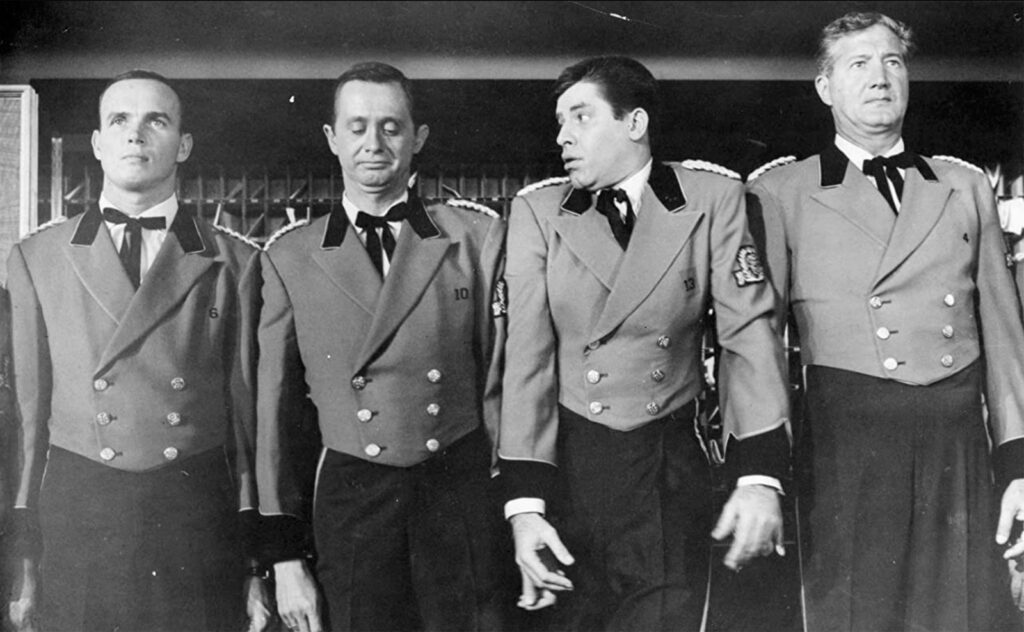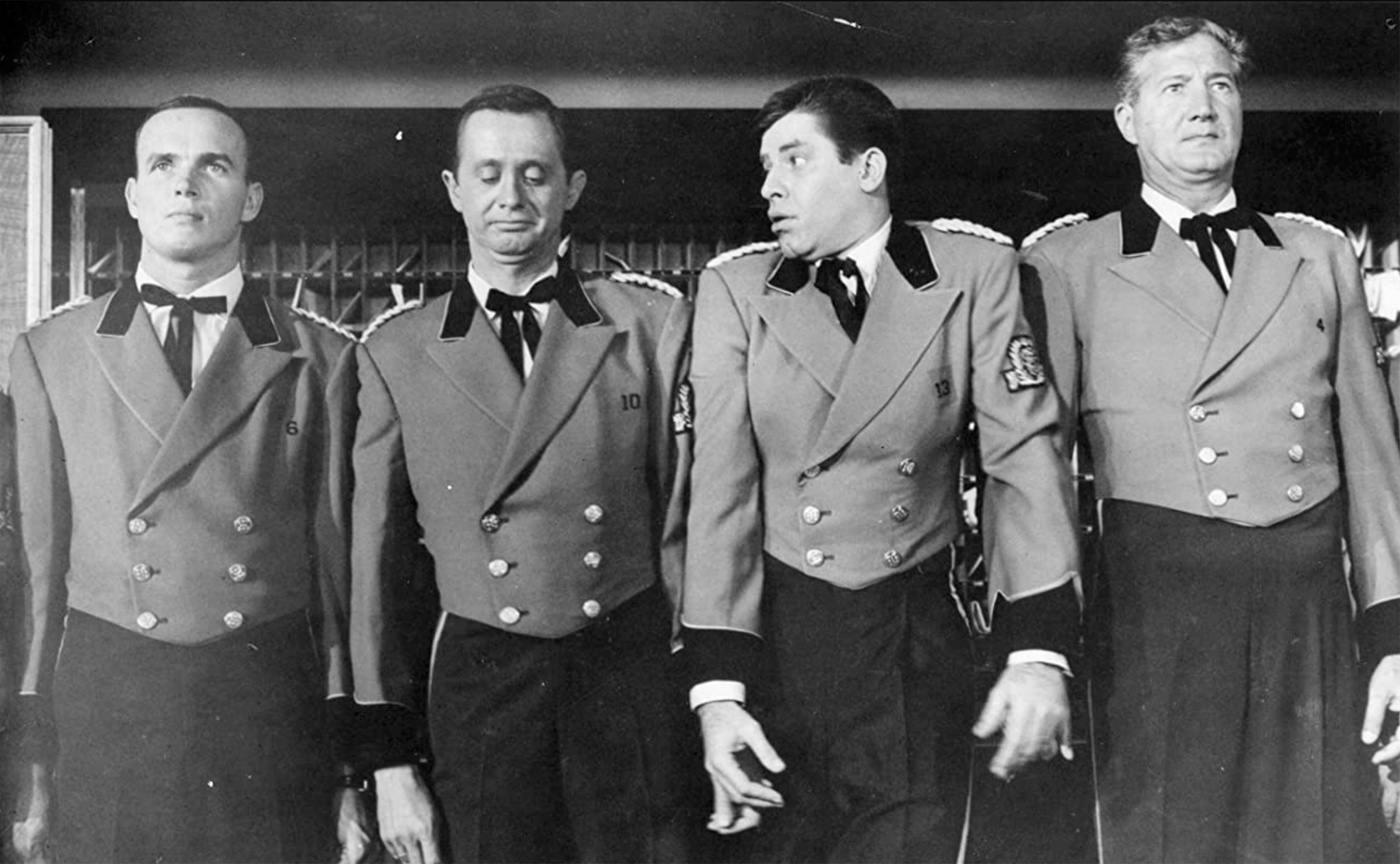It came from France. Ironically similar to the way Sennett was influenced by the physical comedy shorts released by Gaumont and Eclipse, and by Ambrosio in Italy, a sea change in long-form comedy film made its way to American shores in the 1950s. Perhaps because the history and tradition of physical comedy performance ran deeper in France, the success of Jacques Tati’s short flims there led to his move into features. Features which were released in the USA and were successful.
Because, to my mind, without Tati’s Monsieur Hulot’s Holiday (1953) and Mon Oncle (1958) — and possibly his 1949 Jour de Fete (depending on how seen it was here) — there is no Jerry Lewis in The Bellboy (1960), The Ladies Man (1961) and The Errand Boy (1961), Ernie Kovacs in Eugene (1957 and 1961), Blake Edwards’ The Party (1968), or Rowan Atkinson’s “Mr. Bean”. There may not have been a direct, conscious dot-connecting on the part of Mr. Lewis and Mr. Kovacs, but Stanley the bellhop and Eugene the fish-out-of-water at a stodgy private men’s club follow the same “you can do this without a traditional storyline” model as Hulot’s summer at the Hotel de la Plage or friendship with his city-dwelling nephew.
Both Lewis and Kovacs were comedian/auteurs who had an interest in visual and physical comedy. They both instinctively knew there was something else you could in feature films and long-form TV sketches than the standard studio stuff, plunking a comedy character into a vehicle plot.

Blake Edwards had a similar interest in physical and visual humor, and combined with Peter Sellers you had another unreliant-on-dialog comedian-filmmaker, although in this case spread across two beings.
There is an element of vulnerability in innocence in a mute or nonverbal character immersed in a community of talking people. I’m not sure exactly why this occurs for an audience, but the absence of dialog and that character’s communicating through it or our being informed by it draws us in. It’s that right-brain factor that’s such a core element of Silent Film, inviting us to fill in or imagine the thought processes of those characters.This is where a parallel to Silent Film occurs, although what’s more easily noticeable to anyone is just the fact that these characters are silent.
It’s interesting that, in sound films where this is utilized in the 1950s and 1960s, the other-worldliness of Silent Film is aimed at with the use of non-linear narrative, helped along by creative or clever uses of sound.
A wordless character, or one who doesn’t speak in some sequences of a film or television program, is also an island — a break from all the talk and the left-brain-only proceedings — for us in the audience. Harpo perfectly balances the verbal antics of his brothers for us. These wordless characters have a long tradition going back decades and generations, in theatre, mime, circus, vaudeville and music hall, commedia del ‘arte, etc.
Perhaps this is why Tati was emboldened enough to expand this into feature film, and for anyone in the financing or production end of his first couple of features to say ‘yes’ to his efficiency-driven postman or to the vacationing Hulot. And so anything that has followed, from Jackie Gleason’s Gigot (1962) to Rowan Atkinson’s Mr. Bean’s Holiday (2007) follows on the Tati precedent.
Comedy performers who had this in their bones or absorbed it into them who worked in television found opportunities to do “silent” or pantomime sketches, like Red Skelton, Lucille Ball and, possibly with more invention to it, Jerry Lewis and Ernie Kovacs. You had to have the confidence to not talk for a few minutes or more on television, which was a rare condition. Kovacs made 90-second TV commercials for Dutch Masters Cigars that were wordless.
There are many instances that could be cited here where the absence of dialog has been flirted with – Ray Milland in The Thief (1952), sitcom episodes where the main character takes a vow of silence, et al – and I’m not going to go into a long discussion of these. Because although any of these have an absence of or do not rely on dialog, and one could refer to these characters or scenes or films as being “silent”, they are not Silent Films. They exist in the filmed-at-projection-speed, synch-sound world that is only a few simple steps removed from reality.
Silent Film is its own universe. It has its own laws of logic, consequence, gravity and physics. It has a more elastic latitude in its storytelling than sound film, and the amount of data that can be left out or merely suggested is greater. Because we as a viewer or an audience are – as Kevin Brownlow put it – the final participants in the filmmaking process. Silent Film is not just mute, it’s magical.
A small handful of filmmakers have tried their hand at the magic over the decades that followed the silent era. I’ll cover these in the next post.
The first post in this series is here.
The previous post (#59) to this one is here.
